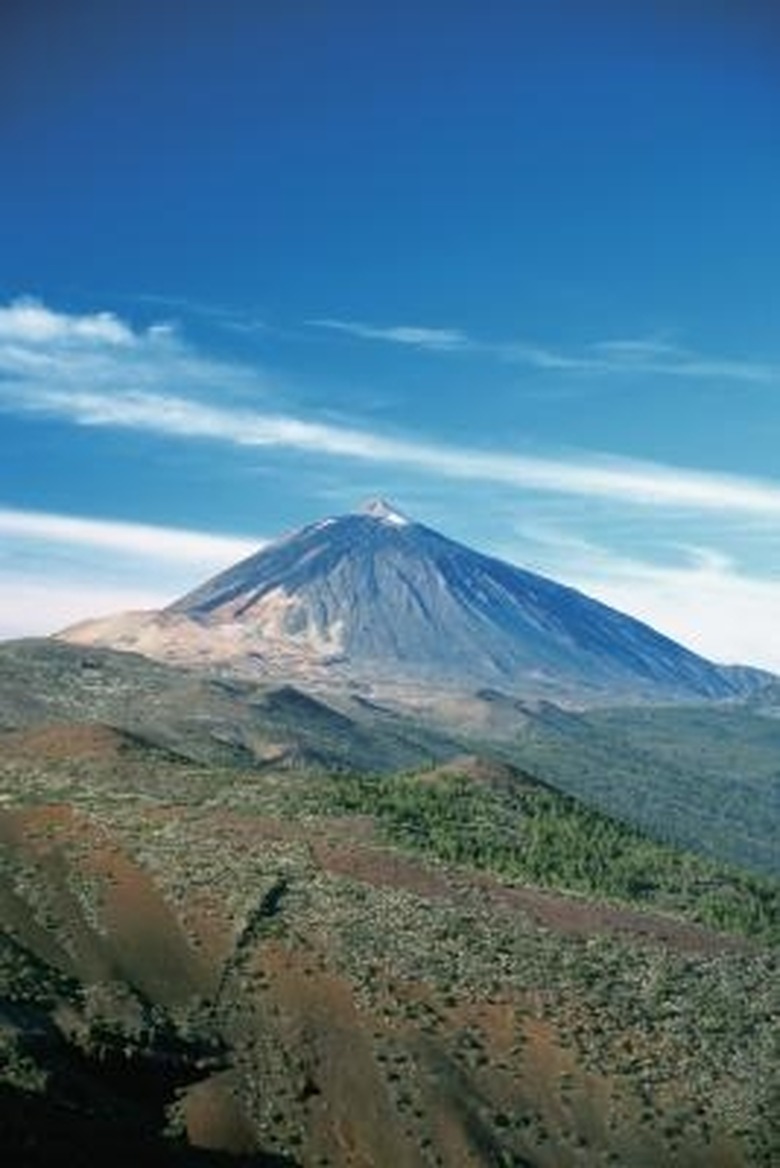Volcanoes & Their Types Of Eruptions
Volcanoes are mountains that result from lava flows or eruptions. The flows and eruptions occur when magma and gases break through Earth's surface, sometimes quietly, sometimes explosively. Volcanoes–named for Vulcan, the Roman god of fire–are classified according to the kind of eruption that formed them.
Shield Volcanoes
Shield Volcanoes
Shield volcanoes usually have quiet eruptions, with lava flows that spread before they cool to make basalt layers. The flows build up to form a low, curved volcano with no steep sides. These volcanoes are most common in ocean areas. Those on Hawaii are shield volcanoes. Since they tend not to be explosive, shield volcanoes are less dangerous than other volcanoes. Shield volcanoes exhibit two types of lava flows: pahoehoe (pah-HOY-hoy), which cools to look ropy; and a'a (ah-ah), which is a blocky flow of rubble.
Cinder Cones
Cinder Cones
Cinder cone volcanoes are formed from pyroclastic eruptions. Pyroclastic refers to particulate matter. Ash is made up of pyroclastic particles smaller than 2 millimeters. Once erupted, ash can fall or flow. Pyroclastic material from 2 to 64 millimeters is called lapilli. The largest pyroclastic materials are bombs or blocks, depending on shape. During a cinder cone eruption, pyroclastic material that looks like cinder shoots up, then rains back down, building a small cone with steep sides. Eruptions are usually short-lived. Wizard Island in Crater Lake, Oregon, is an example of a cinder cone volcano.
Composite Volcanoes
Composite Volcanoes
Composite volcanos, known also as stratovolcanoes, result from both pyroclastic eruptions and lava flows. These volcanoes have steeper sides toward the top, reflecting the pyroclastic element. When the pyroclastic material gets wet, it turns to mud. The resulting mudflow, called lahar, also builds the volcano. Famous composite volcanoes include Mount St. Helens in Washington and Japan's Fujiyama.
Lava Domes
Lava Domes
Lava domes are extremely explosive. Viscous magma builds up as it rises, creating the bulbous lava domes, while gases contained within the magma expand as they get close to the surface. The pressure builds until magma bursts forth in an explosion. Lava domes often eject nuée ardentes, which are clouds of gas, along with the pyroclastic material. Nuée Ardente is French for "glowing cloud." When Mount Pelée in St. Pierre, Martinique, erupted in 1902, the nuée ardente destroyed the town, killing all but a handful of the town's 28,000 people.
Fissure Eruptions
Fissure Eruptions
Sometimes a fissure develops where lava spreads as it breaches the Earth's crust instead of developing a volcano. These fissure eruptions form large basalt plateaus that can cover thousands of square kilometers. Iceland is known for its fissure eruptions.
Plinian Eruptions
Plinian Eruptions
Plinian eruptions eject large amounts of pumice into the air. They are named for Pliny the Younger, who recorded the eruption of Mount Vesuvius in 79 A.D. The eruption destroyed the cities of Pompeii and Herculaneum.
References
- Physical Geology: Exploring the Earth; James S. Monroe and Reed Wicander; 1998
Cite This Article
MLA
Johnson, Sophie. "Volcanoes & Their Types Of Eruptions" sciencing.com, https://www.sciencing.com/volcanoes-types-eruptions-5052923/. 24 April 2017.
APA
Johnson, Sophie. (2017, April 24). Volcanoes & Their Types Of Eruptions. sciencing.com. Retrieved from https://www.sciencing.com/volcanoes-types-eruptions-5052923/
Chicago
Johnson, Sophie. Volcanoes & Their Types Of Eruptions last modified March 24, 2022. https://www.sciencing.com/volcanoes-types-eruptions-5052923/
